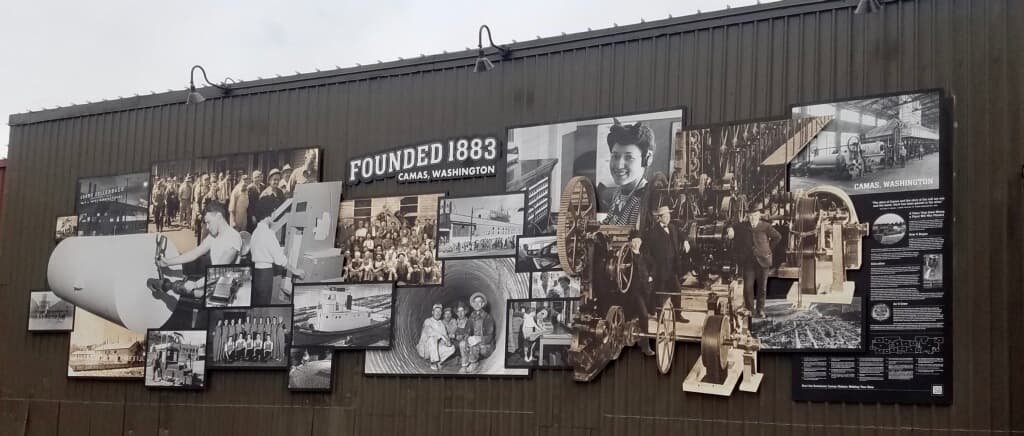
A town that grew where a paper mill was planted….
Imagine you are standing on this spot in 1880. You are in a forest that reaches for miles in all directions. An industry and a town are about to appear. In just a few years, a small but flourishing community will emerge from the vision of “an industrial colony” built around productive papermaking.
How it began…
In 1883, investors led by Henry Pittock, owner of the Oregonian newspaper, purchased 2,600 acres to create the Columbia River Paper Company. He needed a stable supply of newsprint for his and other newspapers. The original 1884 mill was destroyed by fire but rebuilt in brick and back in operation in less than two years. Stores, shops and services emerged to cater to those who lived here, now a town of 500. The year 1906 brought incorporation and later a name change from LaCamas to Camas.
By 1910, in a town of 1,125 people, the mill employed 450 workers – everyone was connected. The mill and its residents were so intertwined that during the Great Depression, all workers were kept on the payroll with at least enough hours to feed their families. No one was laid off.
Education…
Despite economic hardships, a paper school was started in 1932. This ensured that employees gained a detailed understanding of the pulp and papermaking processes. The mill’s commitment and expectations ignited a dedication to learning that continues in Camas today.
Beginning in the late 1930’s, research and development became critical to the mill’s success and to the corporation as a whole, now encompassing many locations around the country. Eventually, the establishment of the company’s research center in Camas led to the development of hundreds of patents by employees. This investment in modern laboratories and pilot facilities drew chemists and engineers and their families to town, instilling in the community the importance of innovation and education.
World War II brought heavy demands to support the war effort. Our Camas mill needed to maintain full production while tackling an entirely new task – converting the mill’s machine shops to produce parts for the Kaiser shipyards in Vancouver. Ship rudders weighing 17 tons, entire cargo cranes, engine parts, winches and tail shafts are just some of the many critical contributions made by the Camas crews. Afterwards, mill owners returned all war contract profits to the government in a gesture of patriotism.
As it grew…
The mill saw many changes of ownership. Crown Columbia merged with Willamette Paper Company forming Crown Willamette, which in turn became Crown Zellerbach. By the 1940’s, Camas boasted the largest specialty paper mill in the world. A new slogan promoted the mill’s expanded product line with “Camas Paper Wraps the World.” At its peak employment in the 1950’s, the workforce numbered over 2,800 while the town’s population stood near 5,000. Through the years, ownership has passed through James River, Fort James and Georgia-Pacific, becoming a subsidiary of Koch Industries in 2005.
As the paper mill took root here, so did a strong community with an unshakable belief in hard work, the value of education and the bond of shared purpose. Life and livelihoods all came together – your neighbors were your mill coworkers, shopkeepers, teachers and friends. We strive to continue those values and connections today and to preserve this powerful legacy. We thank those who led us here.
“The story of Camas and the story of the mill are one and the same.
Each has been geared to the other.”
William D. Welsh, A Brief History of Camas Washington, 1953
The Historic Mill Photo Collage was installed in 2020 by the Downtown Camas Association with support by the Georgia Pacific Foundation, Clark County Historical Commission, Riverview Community Bank and the Locke family. We hope you enjoy this tribute to our mill and that the value and legacy of the mill in our town is forever known.

